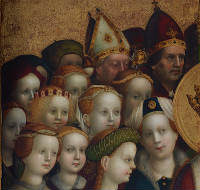Banner with ermine tails and lions
In the top left and bottom right fields of the quartered banner, the brush drawing depicts, in a loose and sometimes stippled manner, a number of ermine tails. These were features of the then arms of Brittany, from where St Ursula was said by tradition to have come. It is hardly a coincidence that the number of ermine tails in the top left field is ten, and in the bottom right eleven. The ten ermine tails will symbolize the ten virgins who, according to the ‘Legenda Aurea’ composed by Jacobus de Voragine in 1363, St Ursula is said to have requested as companions on her planned pilgrimage to Rome. The eleven ermine tails bottom right may then symbolize the wish of St Ursula, recorded in the same source, that she and the ten requested virgins should each have 1000 further companions, making a total of 11,000 virgins in all, abbreviated to the number eleven. The three lions ‘passant guardant’ in the other two quarters relate to the arms of England, a reference to the English royal prince Aetherius, whom St Ursula was to marry.
In the painted version of the banner, the stylized ermine tails give way to a more naturalistic depiction of the white fur, which for the normal beholder of the altarpiece is barely recognizable as such. At the same time the lions were each given a crown, an occasional variant of the English armorial lions.
details & results
projekt von:















